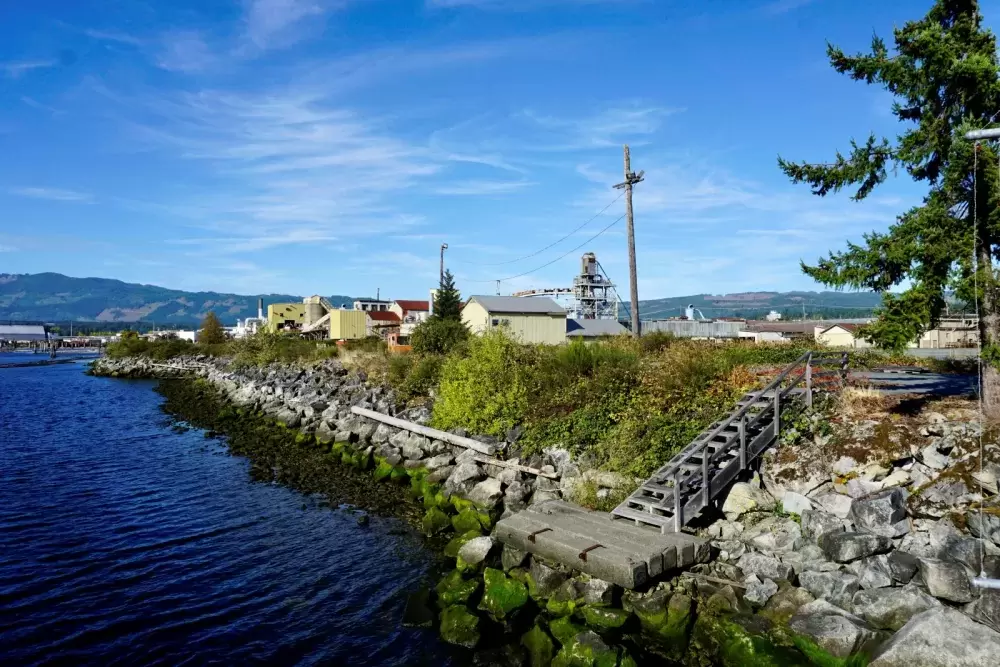The City of Port Alberni has recently purchased five parcels of land from Western Forest Products, including the Somass Sawmill lands, and they plan to continue consultation with local First Nations on redevelopment plans going forward.
The city purchased the five parcels for $5.3 million, which include the property on which Somass Division Sawmill is situated. The properties are currently used as a parking lot for Somass Division Sawmill, with two lots that include Harbour Road and the rail right of way, extending from Argyle Street to the northern gate of Alberni Pacific Division Sawmill and a linear portion of land to be subdivided from a larger parcel on which HemVal Kilns is situated. The portion of land will extend from Dunbar Street and include the bed and upland on both banks of Dry Creek.
The city intends to pay for the properties using funds from the city’s reserves, including the Community Forest Dividend Reserve.
“Acquiring the Somass Lands and adjacent parking lot has been a primary focus of city council since shortly after being elected in 2018,” said Mayor Sharie Minions in a press release. “Remediating and repurposing these lands in a way that recognizes the shifting nature of our vibrant community represents a fundamental shift for the City of Port Alberni. City council is thrilled to be moving forward on the purchase of these properties which is key in actioning the city’s Corproate Strategic Plan.”
The city’s early redevelopment plans for the Somass Sawmill lands include a mix of residential, commercial and light industrial use, along with the proposed Quay to Quay Pathway.
City of Port Alberni CAO Tim Pley said from the time that the city began engaging with the former property owner to purchase the Somass mill site, city council was mindful that the land was immediately adjacent to the former Tseshaht Tlukwatkuis village site.
“From the beginning it has been city council’s intention to be respectful of Tseshaht in the redevelopment of the property,” Pley said. “This is in alignment with the Clock Tower project in the same general area in which the city’s refurbishing project will include installation of Tseshaht art and story boards.”
Pley said the city conducts land sales out of the public eye, and on this purchase the city also had obligations to the other party to not divulge information about the negotiation. Pley added that as soon as the city was able, Hupacasath and Tseshaht were made aware of the pending transfer of ownership, and Hupacasath was made aware that because of the proximity to Tlukwatkuis, the city would explore the potential for Tseshaht to be involved in redevelopment of the land.
“The city endeavours to equally respect the rights and title claims of Hupacasath and Tseshaht First Nations while seeking to partner with each of those nations where it is mutually beneficial to do so,” Pley said. “The city makes every effort to avoid taking actions that might affect the rights and title claim of either nation. The city will continue to discuss with Tseshaht First Nation redevelopment of the Somass lands. The nature of those discussions is confidential.”
Pley added that as for recognizing Indigenous heritage during redevelopment of the lands, it has not been determined yet.
“It seems reasonable to look at another current city project as an example of Indigenous engagement,” Pley said. “Planning for the Connect the Quays project includes a Planning Working Group with two representatives from each of Hupacasath, Tseshaht and the city. The Planning Working Group will provide input on pathway design, Indigenous place names and former use, and cultural significance.”
Tseshaht Chief Councillor Ken Watts said it’s important for the First Nation to be involved in any development around the Harbour Quay because of the historic village site, Tlukwatkuis.
“We’ve been pretty vocal in the past saying that’s an important village site for Tseshaht where we practiced the wolf ritual or really sacred ceremonies,” Watts said. “When [the city] sent their notice of expropriation we sent them a direct letter saying nothing about this area should be done without us.”
Watts said before the city made the purchase announcement they shared some of their visions for the area with Tseshaht that he believes align with the First Nation’s values and their vision for the area.
“I think from what I’ve heard from our citizens and others, what [the city] proposed seems good. It’s a mix of commercial, residential and some light industrial, I think that seems fitting,” Watts said. “The waterfront access I know is really important to a lot of our members…there’s a shortage of docking and wharf space here in the valley so we’re hoping that proceeds, and there’s obviously the creek there that’s really important as well.”
Watts said he’s told the city that he doesn’t just want Tseshaht to be a stakeholder in the project, but to actually be financial contributors.
“We’ll continue to try and do as much as we can with the city, they obviously have their own consultation process with residents and all of that so it’s kind of like a multi-prong approach. They’ll have their conversations and we’ll have ours, but ultimately we’ll have to come together and really figure something out together,” Watts said. “I’m pretty hopeful, I think there’s a lot of benefits to us being a part of a project, it’s not just a recognition of our title or rights, there’s funding opportunities that if we are a part of it the city will be able to tap into as well.”


